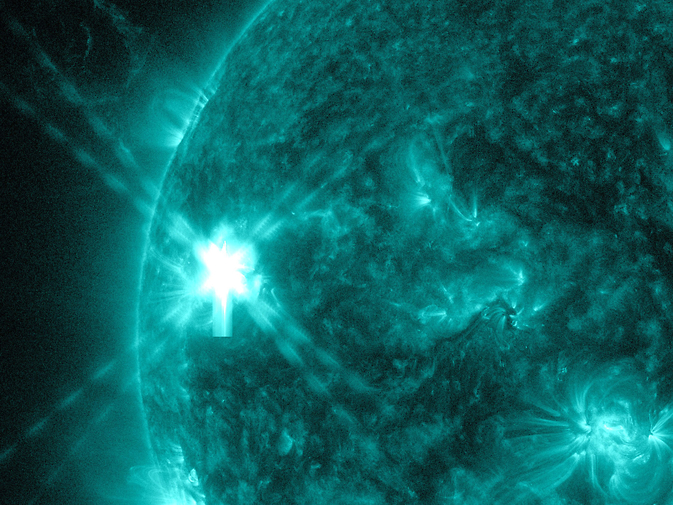NASA's SDO Spots a Summer Solar Flare

A mid-level flare erupted on the left side of the sun on July 8, 2014. This image from NASA's Solar Dynamics Observatory highlights light of 171 Angstroms, which highlights the hot temperature of solar material in a flare and which is typically colorized in teal. Image Credit: NASA/SDO
Solar flares are powerful bursts of radiation. Harmful radiation from a flare cannot pass through Earth's atmosphere to physically affect humans on the ground, however — when intense enough — they can disturb the atmosphere in the layer where GPS and communications signals travel.
To see how this event may affect Earth, please visit NOAA's Space Weather Prediction Center at http://spaceweather.gov, the U.S. government's official source for space weather forecasts, alerts, watches and warnings.
This flare is classified as an M6.5-class flare.
Updates will be provided as they are available on the flare and whether there was an associated coronal mass ejection or CME, another solar phenomenon that can send solar particles into space and affect electronic systems in satellites and on Earth.
What is a solar flare? What is a CME?
For answers to these and other space weather questions, please visit the Spaceweather Frequently Asked Questions page.
Related Link
Karen C. Fox
NASA's Goddard Space Flight Center, Greenbelt, Maryland
Media Contact
All latest news from the category: Physics and Astronomy
This area deals with the fundamental laws and building blocks of nature and how they interact, the properties and the behavior of matter, and research into space and time and their structures.
innovations-report provides in-depth reports and articles on subjects such as astrophysics, laser technologies, nuclear, quantum, particle and solid-state physics, nanotechnologies, planetary research and findings (Mars, Venus) and developments related to the Hubble Telescope.
Newest articles

Bringing bio-inspired robots to life
Nebraska researcher Eric Markvicka gets NSF CAREER Award to pursue manufacture of novel materials for soft robotics and stretchable electronics. Engineers are increasingly eager to develop robots that mimic the…

Bella moths use poison to attract mates
Scientists are closer to finding out how. Pyrrolizidine alkaloids are as bitter and toxic as they are hard to pronounce. They’re produced by several different types of plants and are…

AI tool creates ‘synthetic’ images of cells
…for enhanced microscopy analysis. Observing individual cells through microscopes can reveal a range of important cell biological phenomena that frequently play a role in human diseases, but the process of…





















